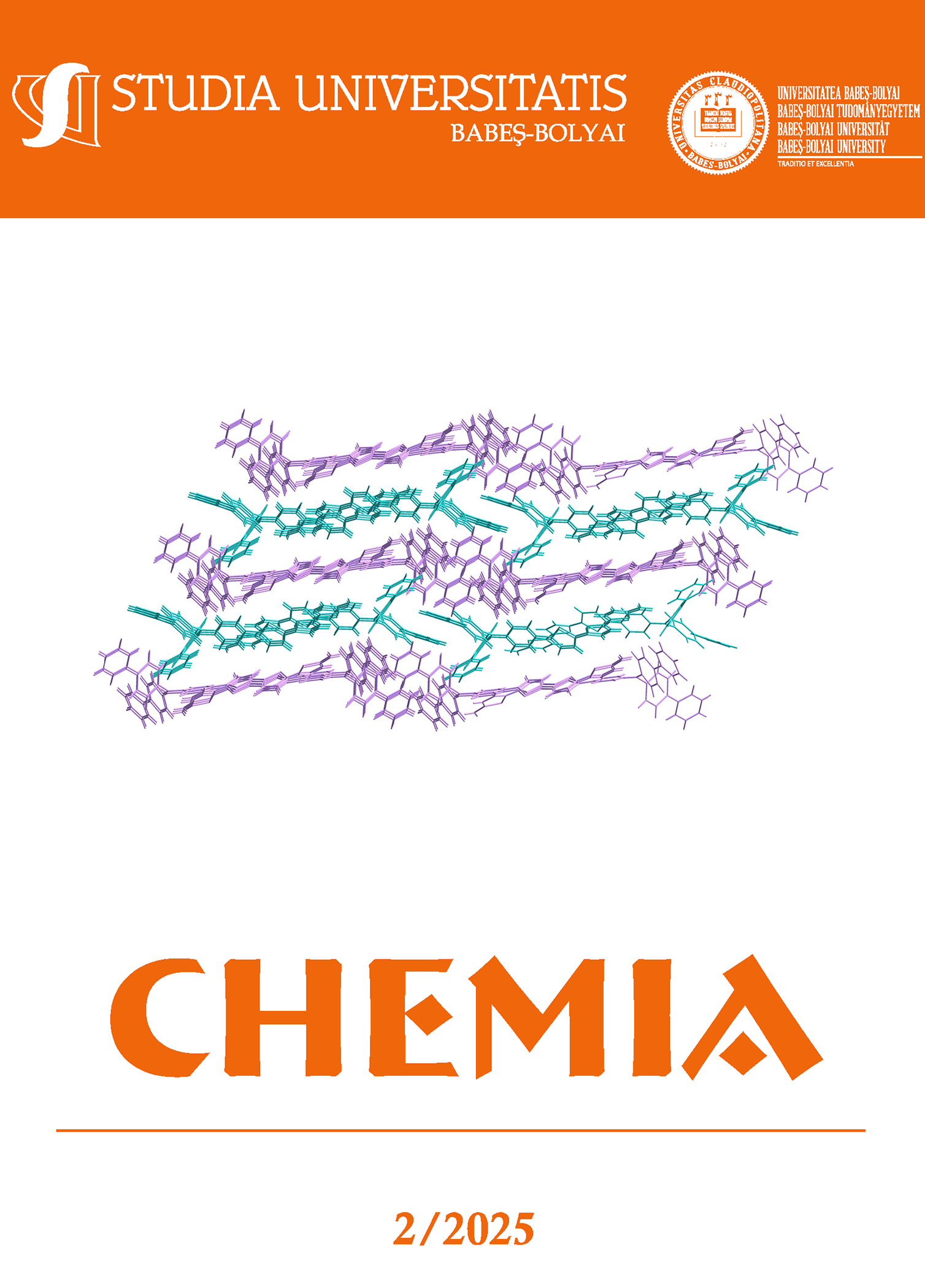CHEMICAL CHARACTERIZATION AND DETERGENT POTENTIAL OF CHELIDONIUM MAJUS EXTRACTS
DOI:
https://doi.org/10.24193/subbchem.2025.2.04Keywords:
Chelidonium majus, accelerated solvent extraction, ultrasound-assisted extraction, alkaloids, flavonoids, polyphenols, antimicrobial activity, antioxidant capacity, extraction efficiencyAbstract
The present study investigates the impact of different extraction methods—accelerated solvent extraction (ASE), ultrasound-assisted extraction (UAE), and maceration on the yield, phytochemical composition, antioxidant activity, and antimicrobial potential of Chelidonium majus extracts. ASE demonstrated the highest extraction yield (85.7%) and alkaloid content (5.4 mg AE/ml), correlating with enhanced antimicrobial activity against Escherichia coli, Staphylococcus aureus, and Candida albicans (lowest MIC values: 3.12%, 2.50%, and 6.25%, respectively). UAE resulted in the highest polyphenol content (15.2 mg GAE/ml) and antioxidant capacity (12.8 ± 1.5 µmol Trolox/ml), suggesting its effectiveness in preserving antioxidant compounds. Maceration produced the lowest bioactive compound yield and biological activity. These findings indicate that ASE is optimal for antimicrobial applications, while UAE is preferable for antioxidant-enriched extracts. The results provide valuable insights for optimizing C. majus extraction in pharmaceutical, food, and cosmetic formulations.
References
1. X.L. Li, Y.P. Sun, M. Wang, Z.B. Wang, H.X. Kuang; Front. pharmacol., 2024, 15, p.1440979.
2. A. E. Segneanu, G. Vlase, T. Vlase, M. V. Ciocalteu, C. Bejenaru, G. Buema & S. Boia; Plants, 2024, 13(5), 734.
3. M. Terzic, S. Fayez, N. M. Fahmy, O. A. Eldahshan, A. I. Uba, S. K. M. Ponniya, S. Selvi, I. Koyuncu, Ö. Yüksekdağ, G. Zengin; Fitoterapia, 2024, 174, p.105835.
4. M. Strzemski, S. Dresler, B. Podkościelna, K. Skic, I. Sowa, D. Załuski, R. Verpoorte, S. Zielińska, P. Krawczyk, M. Wójciak; Molecules, 2022, 27(9), p.2815.
5. T. Tuzimski, A. Petruczynik, T. Plech, B. Kaproń, A. Makuch-Kocka, M. Szultka-Młyńska, J. Misiurek, B. Buszewski, M. Waksmundzka-Hajnos; Int. J. Mol. Sci. 2023, 24(7), p.6360.
6. M. Zwerger, L. Boeck, J. Manzl, S. Schwaiger, M. Ganzera; Planta Med., 2024, 90(07/08), pp.523-533.
7. G. Göger; Chelidonium majus L.. In: Novel Drug Targets With Traditional Herbal Medicines: Scientific and Clinical Evidence 2022, Cham: Springer International Publishing, 2022, pp. 121-129.
8. N. Stefanowski, H. Tkachenko, N. Kurhaluk; Medicinal Herbs: from Past Experience to New Technologies: Proceedings of Ninth International Scientific and Practical Conference, 2021, pp. 154-160.
9. T. Bilušić, I. Šola, V. Čikeš Čulić; Food Technol. Biotechnol., 2024, 62(1), pp.49-58.
10. A. Danila, M. Costea, L. Profire, C.M. Rimbu, M. Baican, F. Lupascu, S. M. Tatarusanu, B. S. Profire, E. I. Muresan; Polymers, 2022, 14(15), p.3194.
11. D. Yue, D. Zheng, Y. Bai, L. Yang, J. Yong, Y. Li; Phytother. Res., 2024, 38(5), pp.2518-2538.
12. E. Gayathiri, P. Prakash, N. Karmegam, S. Varjani, M. K. Awasthi, B. Ravindran; Agronomy, 2022, 12(3), p.662.
13. M. Ayub, M. H. D. Othman, I. U. Khan, S. K. Hubadillah, T. A. Kurniawan, A. F. Ismail, M. A. Rahman, J. Jaafar; J. Clean. Prod., 2021, 295, p.126296.
14. A. K. Chaudhari, V. K. Singh, A. Kedia, S. Das, N. K. Dubey; Environ. Sci. Pollut. Res., 2021, 28, pp.18918-18940.
15. Y. Kunatsa, D. R. Katerere; Plants, 2021, 10(5), p.842.
16. M. E. A. Benarbia, P. Gaignon, C. Manoli, P. Chicoteau; Front. Vet. Sci., 2022, 9, p.946576.
17. J. Lv, S. Liu, C. Hu, L. Ding, H. Wang, X. Li, F. Yang, Q. Shen, H. Zhang, G. Ma, S. Zhang; Front. Plant Sci., 2025, 16, p.1535170.
18. S. Rai, E. Acharya-Siwakoti, A. Kafle, H. P. Devkota, A. Bhattarai; Sci, 2021, 3(4), p.44.
19. M. R. Wylie, D. S. Merrell; Front. Pharmacol., 2022, 13, p.891535.
20. K. D. Rakholiya, M. J. Kaneria, A. M. Shaikh, S. S. Wandhekar, S. V. Chanda; Medicinal plants as alternative sources of therapeutics against multidrug resistant pathogenic microorganisms based on their antimicrobial potential and synergistic properties. In: Fighting multidrug resistance with herbal extracts, essential oils and their components, (Second Edition), Academic Press, 2025, Chapter 12, pp.271-289.
21. E. Guzmán, A. Lucia; Cosmetics, 2021, 8(4), p.114.
22. P. Bolouri, R. Salami, S. Kouhi, M. Kordi, B. Asgari Lajayer, J. Hadian, T. Astatkie; Molecules, 2022, 27(24), p.8999.
23. M. Angane, S. Swift, K. Huang, C. A. Butts, S. Y. Quek; Foods, 2022, 11(3), p.464.
24. A. Mutlu‐Ingok, G. Catalkaya, E. Capanoglu, F. Karbancioglu‐Guler; Food front., 2021, 2(4), pp.508-518.
25. S. Kyoung-Sun, W. Y. Kyeong; Res Crops., 2023, 24(2), pp.378-383.
26. C. Gosset-Erard, M. Zhao, S. Lordel-Madeleine, S. Ennahar; Food Chem., 2021, 352, p.129396.
27. K. Szentmihályi, I. Szőllősi-Varga, M. Then; Eur. Chem. Bull., 2021, 10(1), 58-66.
28. P. Krzyżek, A. Junka, W. Słupski, A. Dołowacka-Jóźwiak, B. J. Płachno, A. Sobiecka, A. Matkowski, G. Chodaczek, T. Płusa, G. Gościniak, et al.; PathogensI, 2021, 10, 1033.
29. A. E. Segneanu, G. Vlase, T. Vlase, M. V. Ciocalteu, C. Bejenaru, G. Buema, L. E. Bejenaru, E. R. Boia, A. Dumitru, S. Boia, 2024. Romanian Wild-Growing Chelidonium majus—An emerging approach to a potential antimicrobial engineering carrier system based on AuNPs: In Vitro investigation and evaluation. Plants, 13(5), p.734.
Downloads
Published
How to Cite
Issue
Section
License
Copyright (c) 2025 Studia Universitatis Babeș-Bolyai Chemia

This work is licensed under a Creative Commons Attribution-NonCommercial-NoDerivatives 4.0 International License.



